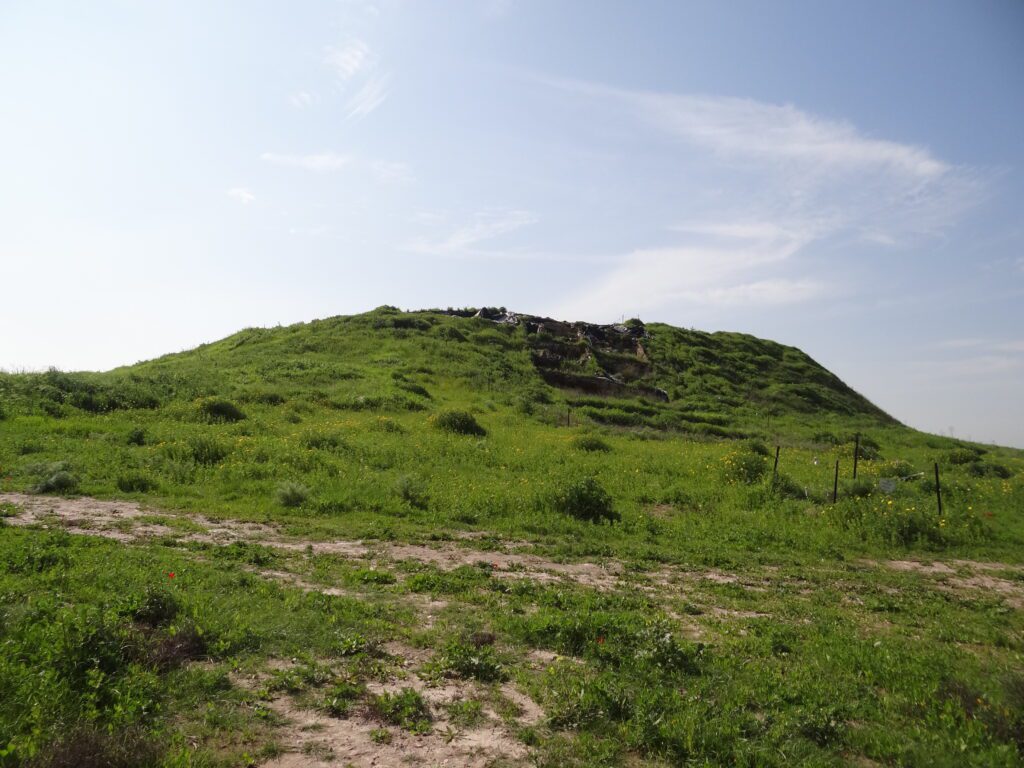Tel Zayit (Arabic: Khirbet Zeita el-Kharab) is located in the Shephelah region near the modern kibbutz of Gal’on. Historically it is halfway between Lachish and Gath, two important urban centers, and 30 km east of Ashkelon, a large coastal port. It spans 7.4 acres and is situated along a road that runs through the Guvrin stream, linking the coastal plain with the Judean highlands. Therefore, the site of Tel Zayit provided a strategic defense. It has a long history of occupation, spanning approximately 3,700 years and experienced significant cultural changes. It was influenced by various entities due to its location in the borderland between Judah and Philistia. The inhabitants of Tel Zayit learned to navigate the challenges and benefits of living in this liminal area.

History of Research
The archaeological exploration of Tel Zayit began in 1998 under the direction of Ron E. Tappy and with the sponsorship of Pittsburgh Theological Seminary. It seems that significant sections of the site were destroyed by agricultural activities in recent centuries. Of particular significance is the discovery of an abecedary, an archaic alphabet, dating to the 10th century BCE. This inscription provides valuable evidence for the evolution of writing in southern Canaan during this period.
Early Tel Zayit and Egyptian dominance (17th-12th centuries BCE)
The early days of settlement at Tel Zayit are shrouded in ambiguity. The earliest evidence of settlement at Tel Zayit is a house dated to around the 15th century BCE, the early days of Egyptian rule in Canaan, though it may have begun as early as the 17th century BCE (Middle Bronze Age). Tel Zayit became a thriving settlement in the 14th century (Late Bronze Age). Two monumental buildings were excavated, their inner walls decorated with red paintings, and their floors were neatly paved. These were destroyed in a violent event, possibly during the turmoil of the Amarna period. The administrative quarter was rebuilt, and several artifacts attest to the richness of the settlement in the 13th-12th centuries BCE. These include many imported ware and ivory objects. The settlement decayed and was abandoned before the end of the Late Bronze Age.
Iron Age: Between Judah and the Philistines (10th-7th century BCE)
Tel Zayit was abandoned for about two centuries until in the Iron IIA period, sometime after 1000 BCE, a new town emerged on the summit of the mound. Two-story structures of the 10th century were discovered which had been burnt in a violent event, probably related to the campaign of Pharaoh Sheshonq I (Biblical Shishak) in the southern Levant. The settlement was rebuilt in the early 9th century BCE. The ceramics at the site show that it had a trade connection with the coastal regions to the west and may have hosted a metal workshop. It would seem plausible that Tel Zayit was a satellite of Philistine Gath in the mid-9th century. Like Gath, it was violently destroyed in the late 9th century, during the campaign of Hazael of Aram-Damascus against the kingdoms of Israel, Judah, and Gath.
The city was rebuilt again in the 8th century BCE. It was part of the Kingdom of Judah as attested by the provenance of LMLK-jars, as well as its proximity to Lachish, an important Judahite center. Like Lachish, Tel Zayit was destroyed in Sennacherib’s campaign against the Shephelah region. Settlement continued later in the 7th century, though its size and nature are yet to be clear as much of the site’s later layers were interrupted and removed by agricultural activities.
Ron E. Tappy has suggested identifying Tel Zayit with the biblical town Libnah, which is said to have rebelled against King Jehoram of Judah in the 9th century BCE (2 Kings 8), and also the hometown of Judahite queen Hamutal, the wife of King Josiah of the 7th century BCE (2 Kings 23). With that said, it has been also to identify Libnah with Tel Burna, another site two kilometers to the east.
Later periods
Only meager remains from the Persian and Hellenistic periods were identified. An impressive fortress of the 2nd and 4th centuries CE was unearthed. The Romans exploited Tel Zayit’s location, overlooking the vast coastal plain from Ashdod to Gaza. The place was abandoned, and a small Muslim village named Khirbet Zeita el-Kharab existed around the 16th century CE.
Sources:
Tappy, R. E. 2017. The Archaeology and History of Tel Zayit: A Record of Liminal Life. In: Lipschits O., Maeir M. (eds.). The Shephelah during the Iron Age: Recent Archaeological Studies. 155-179
Tappy, R. E. 2017. The Archaeology and History of Tel Zayit. Qadmoniot: A Journal for the Antiquities of Eretz-Israel and Bible Lands 154. 78-87 [Hebrew]


